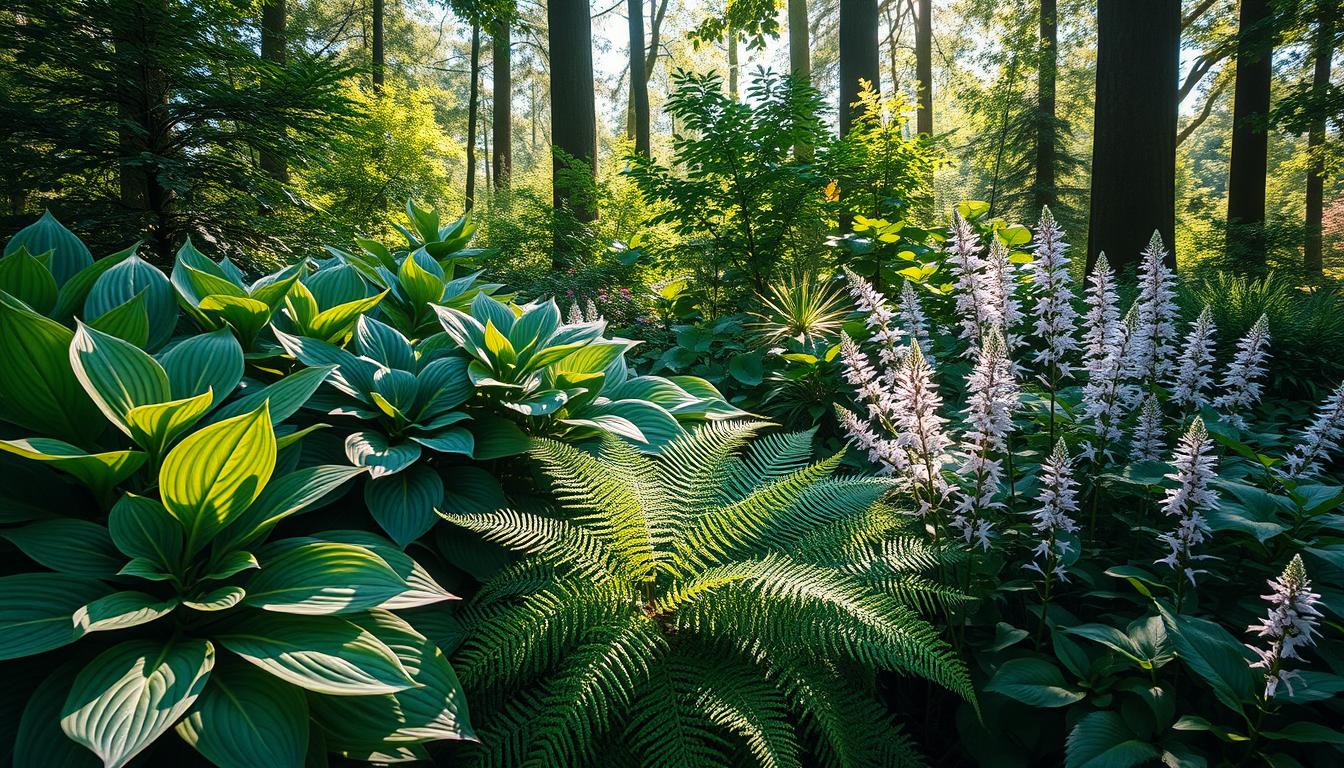I’ve always been fascinated by shade gardens. These cool, dim spaces are a challenge for gardeners. Over the years, I’ve found many shade-loving plants that do well in low light.
In this guide, I’ll share my top picks for shade gardens. We’ll look at everything from lush ferns to colorful impatiens. These plants can make your shady spots green and vibrant, no matter the light.
Let’s explore low light gardening together. I’ll show you how to make even the darkest corners of your yard a vibrant oasis. Let’s start your shade garden journey!
Understanding Shade Gardens
I’ve always been drawn to the calm beauty of shade gardens. These spaces offer a peaceful escape from the sun. They let us grow plants that love the shade. Let me share what I’ve learned about designing shade gardens and how they can change your outdoor area.
What is a Shade Garden?
A shade garden gets little direct sunlight. There are different shades:
- Full shade: Less than 3 hours of direct sun
- Partial shade: 3-6 hours of sun
- Dappled shade: Filtered light through trees
Each shade type changes how plants grow. It affects your design choices.
Benefits of Planting in Shaded Areas
Creating a woodland garden or shaded oasis has many perks:
- Reduced water needs: Plants in shade lose less moisture
- Cooler outdoor spaces: Perfect for hot summer days
- Unique plant options: Many beautiful species thrive in low light
- Lower maintenance: Slower growth means less pruning
These benefits make shade gardens a great choice for any yard. Knowing these basics helps you plan and design your own peaceful shade retreat.
Choosing the Right Plants for Shade
Finding the right plants for your shaded garden is essential. It’s all about understanding your garden’s unique needs. This knowledge is key to a thriving, beautiful space.
Factors to Consider When Selecting Plants
When picking shade-tolerant flowers and shrubs, consider these factors:
- Light levels: Deep shade, partial shade, or dappled sunlight
- Soil type: Clay, loam, or sandy
- Moisture retention: Well-draining or water-retentive
- Plant size at maturity: Ensure enough space for growth
- Bloom time: Plan for year-round interest
Sunlight Exposure vs. Shade Tolerance
It’s important to know the difference between shade tolerance and shade preference. Some shrubs just survive in low light, while others really thrive. Plants labeled as “shade-loving” usually do best in shaded gardens.
| Light Level | Suitable Plants | Characteristics |
|---|---|---|
| Deep Shade | Ferns, Hostas | Thrive with minimal light |
| Partial Shade | Astilbe, Heuchera | Tolerate some direct sunlight |
| Dappled Sunlight | Hydrangeas, Impatiens | Prefer filtered light through trees |
By choosing the right shade-tolerant flowers and shrubs, your garden will flourish. It will be lush and vibrant, thriving every year.
Popular Perennials for Shade Gardens
Perennials are key to a great shade garden. They come back every year, adding beauty with little work. Here are some top picks from my own shaded spots.
Hostas: The Low-Maintenance Kings
Hostas are my top choice for shade gardens. They have lush leaves in many colors and sizes. Along my shaded paths, they’ve grown beautifully over time.
They’re easy to care for, making them ideal for those with busy lives.
Astilbe: Color and Texture Under the Canopy
Astilbes add vibrant colors to my shade garden. Their feathery flowers stand out in dark spots. I mix them with hostas for a beautiful contrast.
Astilbes love moist, well-drained soil and bloom all summer.
Ferns: Add a Lush, Green Look
Ferns give my shade garden a woodland feel. They create a lush layer under the trees. Their delicate fronds add movement and a natural touch.
Ferns are great for shade gardens. They thrive in low light and need little care once they’re established.
| Perennial | Light Preference | Soil Needs | Bloom Time |
|---|---|---|---|
| Hostas | Partial to full shade | Moist, well-drained | Summer |
| Astilbe | Partial shade | Rich, moist | Late spring to summer |
| Ferns | Partial to full shade | Moist, well-drained | Non-flowering |
Beautiful Annuals for Shaded Spaces
Shade-tolerant flowers can brighten up dark garden corners. Annuals are great for adding color in shady spots. Let’s look at two favorites for these areas.
Impatiens: A Classic Choice
Impatiens are perfect for shaded areas. They bloom all season, offering a variety of colors. I like using them in hanging baskets or as borders.
New Guinea impatiens stand out with their big flowers and colorful leaves.
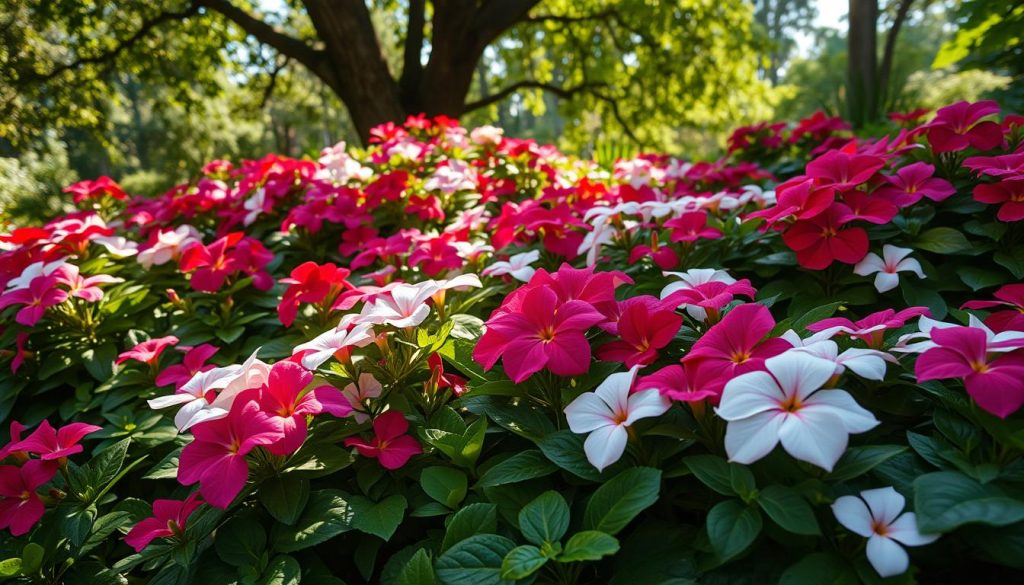
Coleus: Colorful Foliage Options
Coleus shines in low light gardens. Its leaves come in many patterns and colors. I use coleus in container gardens for a bold look.
Mixing different coleus varieties creates a stunning display.
| Annual | Light Preference | Colors Available | Best Uses |
|---|---|---|---|
| Impatiens | Partial to full shade | White, pink, red, orange, purple | Borders, hanging baskets |
| Coleus | Partial shade | Green, red, purple, yellow, pink | Container gardens, accent plants |
Impatiens and coleus are easy to care for. They can turn any shady spot into a vibrant oasis. Try different combinations to create your ideal shade garden.
Ground Cover Plants for Shaded Areas
In my shade garden, I use ground cover plants to make it look lush and unified. These plants fill in bare spots and solve problems in low-light areas. I’ve found two great shade-tolerant ground covers that have changed my garden.
Creeping Thyme: A Low-Growing Wonder
Creeping thyme has been a big help in my shade garden. It grows low and spreads fast, making a thick mat that stops weeds and keeps soil in place. It’s great on slopes where grass can’t grow.
Its small, fragrant leaves smell nice when stepped on. This makes it perfect for planting between stepping stones.
Vinca Minor: A Hardy Survivor
Vinca minor, or periwinkle, is my top choice for shaded areas. It grows well where other plants can’t, and it blooms with blue-purple flowers in spring. I use it to cover big areas under trees where grass won’t grow.
Its shiny leaves add beauty to my garden all year. Both creeping thyme and vinca minor need little care, which is great for busy gardeners. I water them when it’s dry and trim them back if they get too big. These ground covers have made my shade garden look better and more cohesive.
Native Plants for Shade Gardens
I’ve found that native plants are key to a thriving woodland garden. These plants have evolved over thousands of years to fit local conditions. They’re ideal for shaded spots. Let me tell you why I love them and introduce you to some favorites.
Why Native Plants Are Important
Native plants are great for many reasons. They need little care, fight off pests, and attract wildlife. In my garden, I’ve seen more birds and butterflies since adding native plants. They also help keep local ecosystems healthy and diverse.
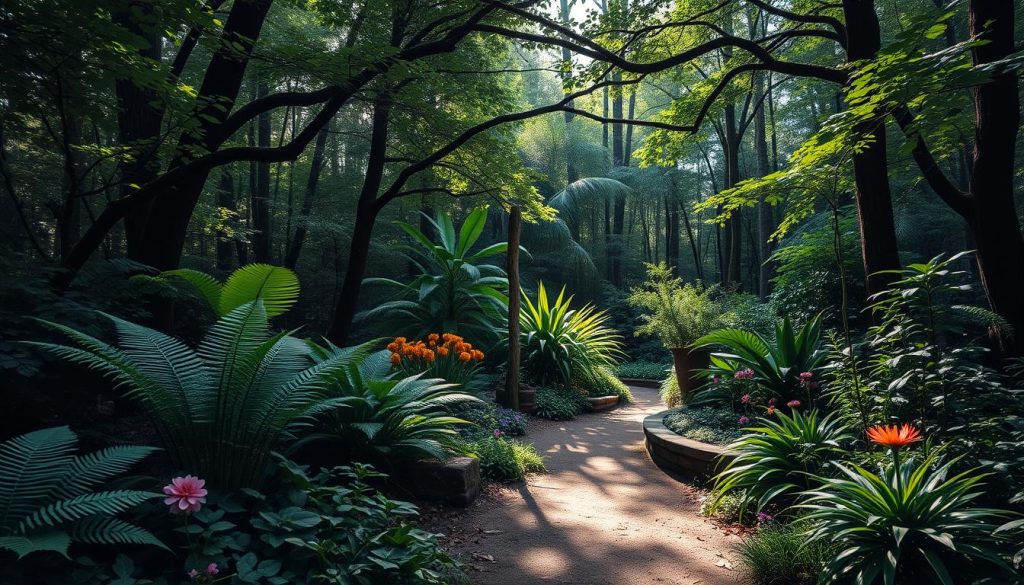
Examples of Shade-Loving Native Plants
Here are some native plants that do well in shade:
- Virginia Bluebells: These spring bloomers fill my garden with blue.
- Trilliums: Their elegant flowers brighten up shady areas.
- Woodland Phlox: This ground cover spreads well under trees.
- Jack-in-the-Pulpit: Its unique shape always draws attention.
- Ferns: Native ferns like maidenhair and wood fern love deep shade.
I buy these plants from local nurseries that focus on native species. Adding them to my garden has made it a beautiful, low-maintenance oasis. It’s good for me and the environment!
Herbs That Thrive in the Shade
Growing herbs in shaded areas is rewarding for those who love low light gardening. I’ve found some great herbs that do well without direct sunlight. Let’s look at two of my favorites that do great in my shade garden.
Mint: Versatile and Aromatic
Mint is a top pick for shade-tolerant shrubs. It grows well in partial shade and spreads quickly. Its scent and uses in cooking make it essential. I keep mint in containers to stop it from spreading too much.
Chives: Flavorful and Hardy
Chives are another herb I enjoy for low light gardening. They add a mild onion taste to food and have pretty purple flowers. I’ve grown chives in spots with just a few hours of sunlight a day. They’re great for filling in gaps between bigger plants.
Mint and chives are easy to care for in the shade. I water them often but don’t overdo it. These herbs are key in my kitchen, offering fresh flavors all year from my shade garden. Try adding these herbs to your shaded areas for a tasty and fragrant touch to your garden.
Strategies for Maintaining Shade Gardens
Keeping a shade garden alive needs special care. I’ve learned a lot about shade garden design. Here are some tips to help your garden thrive.
Watering Tips for Shaded Plants
Watering shade gardens can be tricky. Shaded soil holds moisture longer, but it’s easy to overwater. I check soil dampness with my finger before watering. If it’s dry an inch down, it’s time to water.
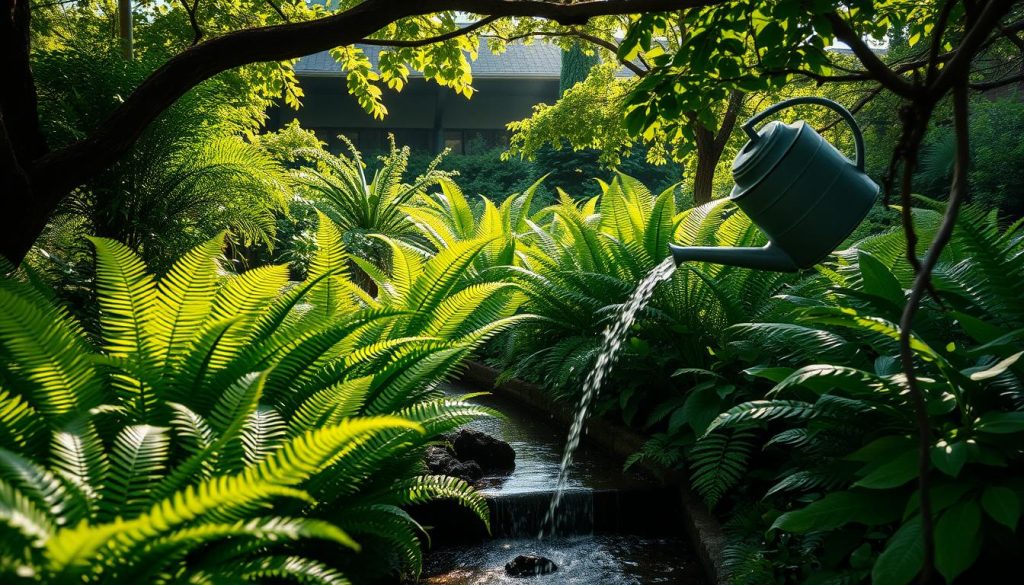
Pruning and Cleaning to Enhance Growth
Regular pruning keeps shade gardens healthy. I trim dead or yellowing leaves to boost air flow and prevent disease. For bushy plants, I thin out dense growth to let light reach inner leaves.
Cleaning up fallen leaves and debris is crucial. This stops pests from hiding and gives plants room to grow.
| Task | Frequency | Benefits |
|---|---|---|
| Water deeply | 1-2 times per week | Encourages deep root growth |
| Prune dead growth | Monthly | Improves air circulation |
| Clean up debris | Weekly | Prevents pest issues |
By following these strategies, you’ll create a lush shade garden. Remember, each garden is unique. So, adjust these tips to fit your space.
Creative Layout Ideas for Shade Gardens
Shade garden design is both a challenge and an opportunity. With careful planning, even a dark corner can become a lush woodland garden. Here are some creative layout ideas that have transformed my shaded spaces.
Layering Plants for Visual Interest
I create depth in my shade garden by layering plants. I start with tall shrubs at the back. Then, I add medium-height perennials, and finish with low-growing ground covers. This method adds dimension and keeps the eye moving.
- Tall layer: Rhododendrons or Japanese maples
- Medium layer: Hostas or ferns
- Low layer: Ajuga or sweet woodruff
Adding Pathways and Hardscapes
Incorporating hardscaping elements elevates my woodland garden design. I use stepping stones to create winding paths that invite exploration. These paths add visual interest and make maintenance easier.
Natural materials work best in shade gardens. Stone, gravel, and wood chips blend seamlessly with the surroundings. For seating areas, I prefer wooden benches that weather gracefully over time.
| Hardscape Element | Material | Benefits |
|---|---|---|
| Pathways | Stepping stones | Easy to install, natural look |
| Seating | Wooden benches | Blends with surroundings, comfortable |
| Borders | River rocks | Defines garden areas, low maintenance |
By combining these elements, I’ve created a shade garden that’s both beautiful and functional. The key is to work with the natural contours of your space and let the plants be the stars of the show.
Common Pests and Diseases in Shade Gardens
Growing shade-loving plants is rewarding but comes with challenges. I’ve faced many pests and diseases in my low light gardening. Let’s look at common issues and natural solutions that work well.
Identifying Common Issues
In my shade garden, slugs and snails are common visitors. They love the moist environment and can quickly damage tender leaves. Fungal diseases also thrive in shady, damp conditions. I’ve learned to spot early signs of powdery mildew and leaf spot on my shade-loving plants.
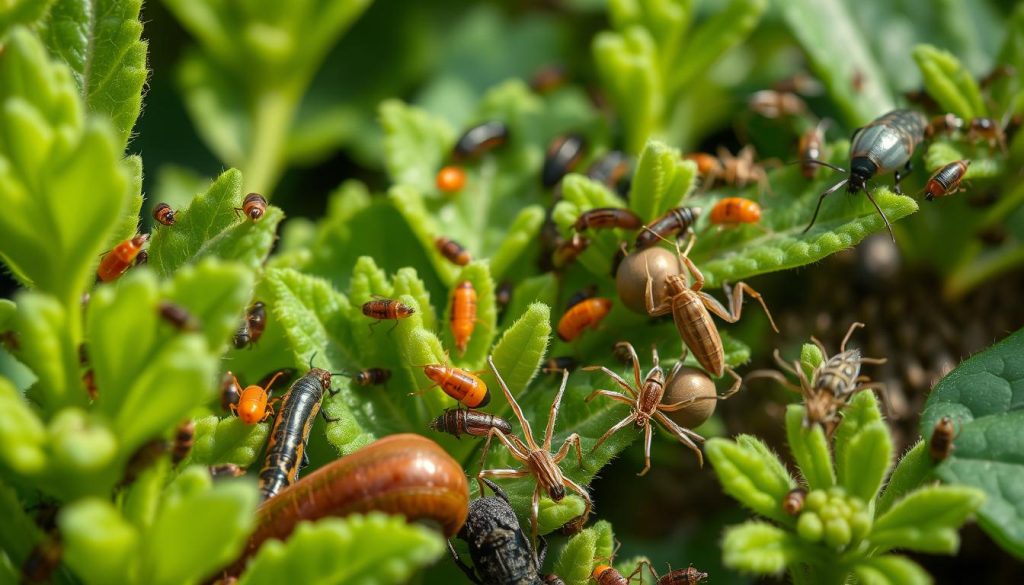
Natural Remedies to Protect Your Plants
I prefer natural solutions for pest control. Coffee grounds scattered around plants deter slugs and snails. For fungal issues, I use a homemade spray of baking soda and water. Companion planting has been a game-changer in my low light gardening. I plant aromatic herbs like mint near susceptible plants to repel pests naturally.
| Pest/Disease | Affected Plants | Natural Remedy |
|---|---|---|
| Slugs/Snails | Hostas, Astilbe | Coffee grounds, Eggshells |
| Powdery Mildew | Phlox, Bee Balm | Baking soda spray |
| Leaf Spot | Ferns, Heuchera | Neem oil solution |
By staying vigilant and using these natural methods, I’ve managed to keep my shade garden thriving. Remember, healthy plants are more resistant to pests and diseases, so proper care is key in low light gardening.
The Role of Mulch in Shade Gardens
Mulch is a game-changer in shade garden design. It’s essential for keeping understory plants healthy and creating a thriving ecosystem. Let’s look at why mulch is key and which types are best for shaded areas.
Benefits of Using Mulch
In my shade garden, mulch is invaluable. It keeps moisture in, which is crucial for plants that fight tree roots for water. It also stops weeds, saving time on maintenance. And, as it breaks down, it improves soil quality and feeds my plants.
Best Mulch Options for Shaded Areas
I’ve tried many mulches in my shade garden. Here are my favorites:
- Leaf mold: It looks like the forest floor and helps plants.
- Pine needles: Great for acid-loving plants and adds a woodland look.
- Shredded hardwood: Lasts long and looks good with the garden.
- Cocoa hulls: Looks nice and smells good, but be careful with pets.
| Mulch Type | Pros | Cons |
|---|---|---|
| Leaf mold | Natural, improves soil | Can be slow to decompose |
| Pine needles | Acidic, good drainage | Not suitable for all plants |
| Shredded hardwood | Durable, attractive | Can rob nitrogen from soil |
| Cocoa hulls | Fragrant, neat appearance | Toxic to pets if ingested |
When using mulch, aim for 2-3 inches. Keep it away from plant stems to avoid rot. With the right mulch, your shade garden will thrive, supporting many understory plants.
Conclusion: My Favorite Shade Plants
As I finish this guide on the best plants for shade gardens, I’m excited to share my favorites. I’ve grown to love the gentle beauty of shade-loving plants. They’ve turned my shaded spots into lush, vibrant spaces.
Reflecting on My Journey with Shade Gardening
My top pick for shade gardens is the versatile hosta. These plants come in many sizes and colors, making them perfect for any shaded area. I also love ferns, which add a touch of wilderness to my garden. Their delicate fronds create a soothing, natural feel that I adore.
Encouragement to Explore Your Own Shade Garden
If you’re thinking about starting a shade garden, I say go for it! Shade-loving plants can turn tricky, low-light spots into magical spaces. Don’t be afraid to try different plants and layouts. With patience and care, you’ll soon have a cool, peaceful retreat in your backyard.
Remember, the best plants for shade gardens are often the ones that bring you joy. So take your time, explore your options, and enjoy creating your own shaded oasis. Happy gardening!

